Dukaches had their own stylistic features in each region due to the influence of various
factors. So-called Volyn dukaches form a separate group. The main feature of Volyn
dukaches is the variety of its forms. They are so different that sometimes it's hard to say
that they are all from Volyn region. Volyn dukaches substantially differ from their
prototypes which were worn by Ukrainian women in other regions. At the same time
adornments that were very similar to the Podil-type dukaches were widely spread in
separate regions of Volyn. Because of this, sometimes it can be very difficult to identify
the place of origin of a dukach adornment. It is explained by the fact that Volyn is at the
crossroads of various cultures (Ukrainian, Belorussian, Lithuanian, Polish, Jewish,
Hungarian and Austrian). That’s why alongside with the traditional Ukrainian forms and
production methods, artwork elements of other nations have had greater influence on
Volyn dukaches more than on other types of these adornments.
factors. So-called Volyn dukaches form a separate group. The main feature of Volyn
dukaches is the variety of its forms. They are so different that sometimes it's hard to say
that they are all from Volyn region. Volyn dukaches substantially differ from their
prototypes which were worn by Ukrainian women in other regions. At the same time
adornments that were very similar to the Podil-type dukaches were widely spread in
separate regions of Volyn. Because of this, sometimes it can be very difficult to identify
the place of origin of a dukach adornment. It is explained by the fact that Volyn is at the
crossroads of various cultures (Ukrainian, Belorussian, Lithuanian, Polish, Jewish,
Hungarian and Austrian). That’s why alongside with the traditional Ukrainian forms and
production methods, artwork elements of other nations have had greater influence on
Volyn dukaches more than on other types of these adornments.
 |
| Volyn dukach* |
*XIX century dukach from the collection of Valerii Anisimov. Koretsk region, Rivne oblast. A medallion is a golden coin of the Russian Emperor Petr III. It is a very rare numismatic material. The edging (a brooch in the shape of a bow) is made of silver.
The medallion is the key element in Volyn dukaches whereas the bow just visually
supplements it or it can be missing at all. Very often the medallion looks like a laced
brooch with the medallion placed in the centre of it. This happens because the medallion
has a pompous trimming.
supplements it or it can be missing at all. Very often the medallion looks like a laced
brooch with the medallion placed in the centre of it. This happens because the medallion
has a pompous trimming.
As a rule, golden coins were mostly used as medallions. Volyn dukaches of the 19th – the
beginning of the 20th century often contained thalers that belonged to the
Austro-Hungarian Empress named Maria Theresa, thalers of Maksimilian Bavarski,
Polish coins and the coins of the Russian Empire. The XX century was very cruel and
very difficult for the history of mankind. The Ukrainian people suffered in World War I
and World War II, took part in the national liberation movement, were oppressed by the
pacification politics introduced by the Polish government and became victims of the
Soviet terror (no other nation has suffered such a great number of tragedies during one
century). People tried to survive and gold helped them in that, as it often happened in
history. During those hard times golden coins, that were a part of adornments, were
massively taken out of them by their owners. Because of this reason, there are very few
copies of dukaches that have been preserved full till nowadays.
beginning of the 20th century often contained thalers that belonged to the
Austro-Hungarian Empress named Maria Theresa, thalers of Maksimilian Bavarski,
Polish coins and the coins of the Russian Empire. The XX century was very cruel and
very difficult for the history of mankind. The Ukrainian people suffered in World War I
and World War II, took part in the national liberation movement, were oppressed by the
pacification politics introduced by the Polish government and became victims of the
Soviet terror (no other nation has suffered such a great number of tragedies during one
century). People tried to survive and gold helped them in that, as it often happened in
history. During those hard times golden coins, that were a part of adornments, were
massively taken out of them by their owners. Because of this reason, there are very few
copies of dukaches that have been preserved full till nowadays.
 |
| Volyn dukach ** |
 |
| Volyn dukach 3* |
** The beginning of the XX century dukach from the collection of Yurii Kovalenko. The medallion is the copy of the golden coin of the Russian Emperor Nicholas II. The edging (dukach’s brooch in the shape of a bow) is made of silver.
3* The reconstruction of the XIX century dukach made by Yurii Kovalenko. The medallion is a Polish silver coin with Hedwig. The edging (dukach’s brooch in the shape of a bow) is made of silver.
Dukaches, having the medallion adorned with a crown or the bow in the shape of a
crown, enjoyed great popularity among women who lived in Volyn region. The crown,
being an element of the dukach trimming, can be found in different regions where it had
been worn. However, Volyn dukaches have the crown made in its own special shape
which is not typical for dukaches of other geographical locations. At this point you can
notice the influence of the Western-European culture, because on the outside it looks like
the insignia of the Western-European monarchs.
crown, enjoyed great popularity among women who lived in Volyn region. The crown,
being an element of the dukach trimming, can be found in different regions where it had
been worn. However, Volyn dukaches have the crown made in its own special shape
which is not typical for dukaches of other geographical locations. At this point you can
notice the influence of the Western-European culture, because on the outside it looks like
the insignia of the Western-European monarchs.
 |
| Volyn dukach 5* |
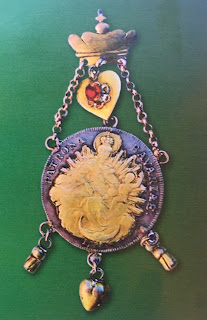 |
| Volyn dukach 4* |
4* The XIX century dukach from the collection of the Bilotserkovskyi Regional Museum of Local Lore, History and Economy. The medallion of “The Patron of Bavaria”, silver, gilt.
5* The reconstruction of the XIX century dukach made by Yurii Kovalenko. The medallion is the copy of “The Patron of Bavaria”, silver. The bow of the dukach is made of silver.
Such an element of the folk art as the image of two birds looking at each other located on
both sides of the crown is often used in the trimmings of Volyn dukaches. Other separate
elements of the floral ornament, such as flowers, which are characteristic for the folk art
by their shape, are also often used. Polish historian Yulian Bartoshevich mentions that the
residents of Volyn region always remained true to old customs and traditions.
both sides of the crown is often used in the trimmings of Volyn dukaches. Other separate
elements of the floral ornament, such as flowers, which are characteristic for the folk art
by their shape, are also often used. Polish historian Yulian Bartoshevich mentions that the
residents of Volyn region always remained true to old customs and traditions.
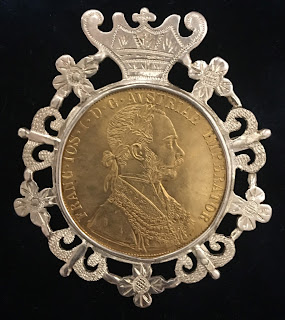 |
| Volyn dukach 6* |
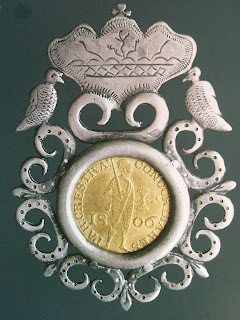 |
| Volyn dukach 7* |
6* The reconstruction of the XIX century dukach made by Yurii Kovalenko. The medallion is the copy of the 4 ducat coin of the Austrian emperor Franz Joseph I, silver, gilt. The edging (a brooch in the shape of a bow) of the dukach is made of silver.
7* The XIX century dukach from the collection of Yevpak O.V. The medallion is the Dutch golden ducat of 1806. The edging (a brooch in the shape of a bow) of the dukach is made of silver.
It was common practice in Volyn region to decorate dukaches with corals. Dukaches,
having the medallion adorned with corals, were particularly popular among the women
who lived in Volyn region.
having the medallion adorned with corals, were particularly popular among the women
who lived in Volyn region.
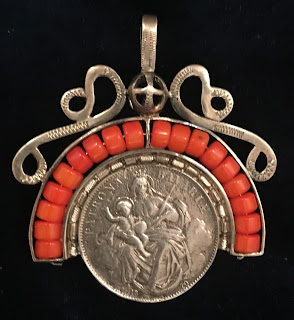 |
| Volyn dukach with corals *8 |
 |
| Volyn dukach with corals 9* |
8* The reconstruction of the XIX century dukach with corals made by Yurii Kovalenko. The medallion is the copy of “The Patron of Bavaria”, silver. The edging – silver, corals.
9* The beginning of the XX century dukach with corals from the collection of Yurii Kovalenko. The medallion is the 20 kopiika silver coin of the Russian Emperor Nicholas II. The edging – silver, corals.
All in all, among Volyn dukaches you can often come across adornments made with a
rather high level of jewellery mastership including the ones that had been made with the
help of the filigree technique. The latter were made by more professional local craftsmen.
Very often the traditional Ukrainian adornment was made by Jewish goldsmiths. A very
limited number of filigree dukaches has remained till the present days.
rather high level of jewellery mastership including the ones that had been made with the
help of the filigree technique. The latter were made by more professional local craftsmen.
Very often the traditional Ukrainian adornment was made by Jewish goldsmiths. A very
limited number of filigree dukaches has remained till the present days.
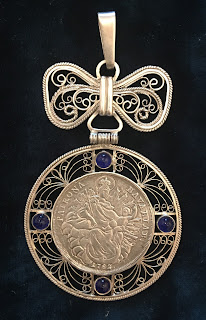 |
| Volyn dukach, filigree 10* |
10* The reconstruction of the century dukach made by Valentyn Kikot with the help of the filigree technique. The medallion is the copy of “The Patron of Bavaria”, silver, the bow is made of silver and glass. The original of this dukach was sold in Kyiv at the beginning of the 1980s of the XX century. The reconstruction is made according to the image produced by Yurii Kovalenko.
Sometimes the edging of a dukach could be made according to the custom design. It is
interesting to mention that if to take this fact into account, there is only one Volyn dukach
while producing which the goldsmith used the element that was similar to the element
that could be found on the Brama Coat of Arms.
interesting to mention that if to take this fact into account, there is only one Volyn dukach
while producing which the goldsmith used the element that was similar to the element
that could be found on the Brama Coat of Arms.
 |
| Volyn dukach, a so-called “Brama Coat of Arms” 11* |
11* The reconstruction of the XIX century dukach made by Yurii Kovalenko. The medallion is a 20 kopiika silver coin that belonged to the Russian Empress Catherine the Great. It is made of gilt. The bow (the brooch) is made of silver.
According to the assumption made by Oleksandr Samkov, the researcher of the traditional
Ukrainian adornments, at the top of the dukach you can see an element that belonged to
the family coat of arms of the Oginski dynasty. Oginski dynasty is an old Ukrainian
honoured baron family of the Baron Coat of Arms. Its representatives made a significant
influence on the development of state, socio-political and cultural processes in the history
of Belorus, Lithuania, Poland, Ukraine and Russia. Oginski dynasty bears its roots from
the Chernihiv Rurikid stock, Mykhailo Chernihivskii in particular.
Ukrainian adornments, at the top of the dukach you can see an element that belonged to
the family coat of arms of the Oginski dynasty. Oginski dynasty is an old Ukrainian
honoured baron family of the Baron Coat of Arms. Its representatives made a significant
influence on the development of state, socio-political and cultural processes in the history
of Belorus, Lithuania, Poland, Ukraine and Russia. Oginski dynasty bears its roots from
the Chernihiv Rurikid stock, Mykhailo Chernihivskii in particular.
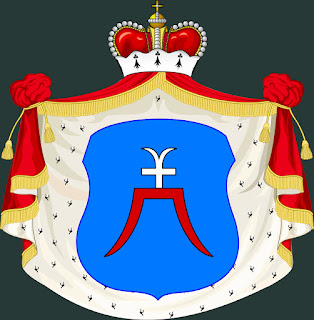 |
| Brama Coat of Arms |
The assumption about the fact that the element of the family coat of arms has been used
in the production of a traditional national adornment is considered to be rather logical.
From the very start dukaches weren’t the adornments that had been worn by the women
who lived in rural areas. Highly likely that one day one of the representatives of the
Oginski dynasty asked the goldsmith to make an individual order to produce a dukach
that would have a certain family attribute in it.
in the production of a traditional national adornment is considered to be rather logical.
From the very start dukaches weren’t the adornments that had been worn by the women
who lived in rural areas. Highly likely that one day one of the representatives of the
Oginski dynasty asked the goldsmith to make an individual order to produce a dukach
that would have a certain family attribute in it.
According to the historian called Oleh Odnorozhenko, the women of Volyn region mostly
used ancient family emblems not having changed them into the Polish ones. He mentions
that the coats of arms of the Chernihiv Rurikid dynasty descendants, Oginski dynasty of
the XV – the beginning of the XVI century in particular, are absolutely similar to the
attributes of Chernihiv dynasty dukes of the XI – XIII century. In order to compare these
attributes below you can find the Chernihiv region Coat of Arms that was confirmed in
the year of 2000. In the middle of the Coat of Arms there is a shield that bears the
attribute of the founder of the Great Principality of Chernihiv Mstislav Volodymyrovych
(the years of his principality in Chernihiv are between 1024 and 1036).
used ancient family emblems not having changed them into the Polish ones. He mentions
that the coats of arms of the Chernihiv Rurikid dynasty descendants, Oginski dynasty of
the XV – the beginning of the XVI century in particular, are absolutely similar to the
attributes of Chernihiv dynasty dukes of the XI – XIII century. In order to compare these
attributes below you can find the Chernihiv region Coat of Arms that was confirmed in
the year of 2000. In the middle of the Coat of Arms there is a shield that bears the
attribute of the founder of the Great Principality of Chernihiv Mstislav Volodymyrovych
(the years of his principality in Chernihiv are between 1024 and 1036).
 |
| Chernihiv Region Coat of Arms that was confirmed in 2000 |
It is probable that the dukach that bears the element of the family coat of arms had to
become a personalized adornment that would have to identify the owner it belonged to.
That would be similar to the adornments that are being worn nowadays which bear the
image with the owners’ initials, the country’s coat of arms or the zodiac signs. It is worth
mentioning that nowadays it has become very popular in Ukraine to wear the adornments
with the image of the National Coat of Arms of Ukraine, the Trident, on them. It may
happen that such kind of a dukach had to become a kind of an amulet for its owner and
the element of the coat of arms that was depicted on it had to perform corresponding
functions. In other words, in this case the family attribute served as a rune, a pictogram
or other symbol of magical nature. Even nowadays a great number of people all over the
world are wearing adornments that bear different ancient signs and people believe that
these adornments have magical powers.
become a personalized adornment that would have to identify the owner it belonged to.
That would be similar to the adornments that are being worn nowadays which bear the
image with the owners’ initials, the country’s coat of arms or the zodiac signs. It is worth
mentioning that nowadays it has become very popular in Ukraine to wear the adornments
with the image of the National Coat of Arms of Ukraine, the Trident, on them. It may
happen that such kind of a dukach had to become a kind of an amulet for its owner and
the element of the coat of arms that was depicted on it had to perform corresponding
functions. In other words, in this case the family attribute served as a rune, a pictogram
or other symbol of magical nature. Even nowadays a great number of people all over the
world are wearing adornments that bear different ancient signs and people believe that
these adornments have magical powers.
As time went by, the goldsmiths or their descendants started using this form to make
other orders. It is highly probable that the original meaning of the upper element of the
edging of a dukach has been simply forgotten and later it mostly indicated the place of
origin of its owner. The owners of these lands moved out and the local women kept
wearing this adornment. It is similar to the fact that the coats of arms of the former
owner keep living on the walls of a castle.
other orders. It is highly probable that the original meaning of the upper element of the
edging of a dukach has been simply forgotten and later it mostly indicated the place of
origin of its owner. The owners of these lands moved out and the local women kept
wearing this adornment. It is similar to the fact that the coats of arms of the former
owner keep living on the walls of a castle.
Thus dukaches reveal the cultural versatility of Volyn region as well as its history and serve as a certain source of the historical genealogy of Ukraine.
Yaroslava Kovalenko
PhD in History
Other publications:
- Award Medals in Dukach Adornments
- Dukach is a signet that symbolizes Ukrainian heritage
- The medallions among dukaches: the mental and the earthy
- Yahnusok - dukach with "a heart"
- Earrings – Ukrainian folk adornments the second half of XIX-early XX century
- Biblical plots in dukaches
- Dukaches of South-Eastern Slobozhanshchina: Dnipropetrovsk Region



Коментарі
Дописати коментар